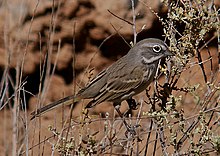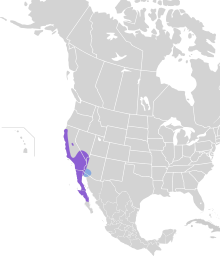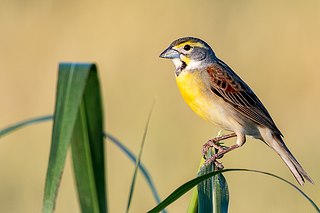
Cardinalidae is a family of New World-endemic passerine birds that consists of cardinals, grosbeaks, and buntings. It also includes several other genera such as the tanager-like Piranga and the warbler-like Granatellus. Membership of this family is not easily defined by a single or even a set of physical characteristics, but instead by molecular work. Among songbirds, they range from average-sized to relatively large, and have stout features, some species with large, heavy bills.

The greater sage-grouse, also known as the sagehen, is the largest grouse in North America. Its range is sagebrush country in the western United States and southern Alberta and Saskatchewan, Canada. It was known as simply the sage grouse until the Gunnison sage-grouse was recognized as a separate species in 2000. The Mono Basin population of sage grouse may also be distinct.

The fox sparrow is a large New World sparrow. It is the only member of the genus Passerella, although some authors split the species into four.
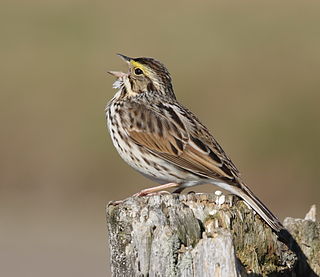
The Savannah sparrow is a small New World sparrow. It used to be the only member of the genus Passerculus and is now the only widely accepted member. Comparison of mtDNA NADH dehydrogenase subunit 2 and 3 sequences indicates that the Ipswich sparrow, formerly usually considered a valid species, is a well-marked subspecies of the Savannah sparrow, whereas the southwestern large-billed sparrow should be recognized as a distinct species.

The black-throated gray warbler or black-throated grey warbler is a passerine bird of the New World warbler family Parulidae. It is 13 cm (5.1 in) long and has gray and white plumage with black markings. The male has the bold black throat of its name, and black stripes on its head, as well as black streaks on its flanks; the female is a paler version of the male, with a white throat and less distinct black markings on the flanks and wings. It breeds in western North America from British Columbia to New Mexico, and winters in Mexico and the southwestern United States. The habitats it prefers are coniferous and mixed forests and scrubland, especially those with pinyon pines, junipers, sagebrush, and oaks. Its nest is an open cup of plant fibers lined with feathers, built a few metres from the ground in the branches of a tree or shrub. Three to five eggs are laid, and young are fed by both parents. Common in its breeding range, it does not seem to be seriously threatened by human activities, unlike many migratory warblers.

Brewer's sparrow is a small, slim species of American sparrow in the family Passerellidae. This bird was named after the ornithologist Thomas Mayo Brewer.

The California gnatcatcher is a small 10.8 cm (4.3 in) long insectivorous bird which frequents dense coastal sage scrub growth. This species was recently split from the similar black-tailed gnatcatcher of the Sonoran and Chihuahuan deserts. This bird is often solitary, but joins with other birds in winter flocks.

The sagebrush sparrow is a medium-sized sparrow of the western United States and northwestern Mexico. It used to be placed in the genus Amphispiza, but evidence from 2007 and 2009 suggested it be placed in its own genus.
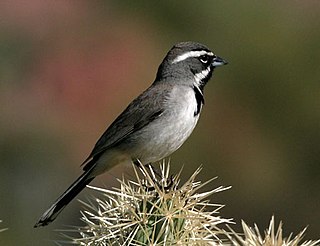
The black-throated sparrow is a small New World sparrow primarily found in the southwestern United States and Mexico. It is the only member of the genus Amphispiza; the five-striped sparrow, formerly also classified in Amphispiza, is now thought to be in the monotypic genus Amphispizopsis.

The black-chinned sparrow is a small bird in the genus Spizella, in the New World sparrow family Passerellidae. It is found in the southwestern United States and throughout much of Mexico north of the Isthmus of Tehuantepec; most populations in the US migrate south after breeding while those in Mexico are resident. It is a slim, long-tailed bird, primarily gray with a reddish-brown back streaked with black, brown wings and tail, a pink beak, and brownish legs and feet. In the breeding season, the male shows black on his throat, chin, and the front of his face. Females, youngsters and nonbreeding males show little or no black in these areas. An unobtrusive bird, it spends much of its time foraging slowly along the ground, either alone or in small groups, sometimes mixing with other Spizella species. It is an omnivore, feeding primarily on seeds during the winter and insects during the summer. It builds a cup-shaped nest of grasses, rootlets, or plant fibers, into which the female lays 2–5 pale blue eggs. The female does most or all of the egg incubation, but both parents feed the hatched nestlings.

The rufous-crowned sparrow is a small American sparrow. This passerine is primarily found across the Southwestern United States and much of the interior of Mexico, south to the transverse mountain range, and to the Pacific coast to the southwest of the transverse range. Its distribution is patchy, with populations often being isolated from each other. Twelve subspecies are generally recognized, though up to eighteen have been suggested. This bird has a brown back with darker streaks and gray underparts. The crown is rufous, and the face and supercilium are gray with a brown or rufous streak extending from each eye and a thick black malar streak.

The green-tailed towhee is the smallest towhee, but is still one of the larger members of the American sparrow family Passerellidae.

The California thrasher is a large member of family Mimidae found primarily in chaparral habitat in California and Baja California. It is the only species of Toxostoma throughout most of its range.

Red fox sparrow is the collective name for the most brightly colored taxa in the American sparrow genus Passerella, the Passerella iliaca iliaca group.

The slate-colored fox sparrow group comprises the Rocky Mountain taxa in the genus Passerella. It is currently classified as a "subspecies group" within the fox sparrows pending a more-thorough genetic assay of all forms.

New World sparrows are a group of mainly New World passerine birds, forming the family Passerellidae. They are seed-eating birds with conical bills, brown or gray in color, and many species have distinctive head patterns.

The moustached brushfinch is a species of bird in the family Passerellidae.

The California coastal sage and chaparral is a Mediterranean forests, woodlands, and scrub ecoregion located in southwestern California and northwestern Baja California (Mexico). It is part of the larger California chaparral and woodlands ecoregion.

The Wyoming Basin shrub steppe ecoregion, within the deserts and xeric shrublands biome, is a shrub steppe in the northwestern United States.
Sage sparrow was the name of a species of sparrow that has since been reclassified as two species:
